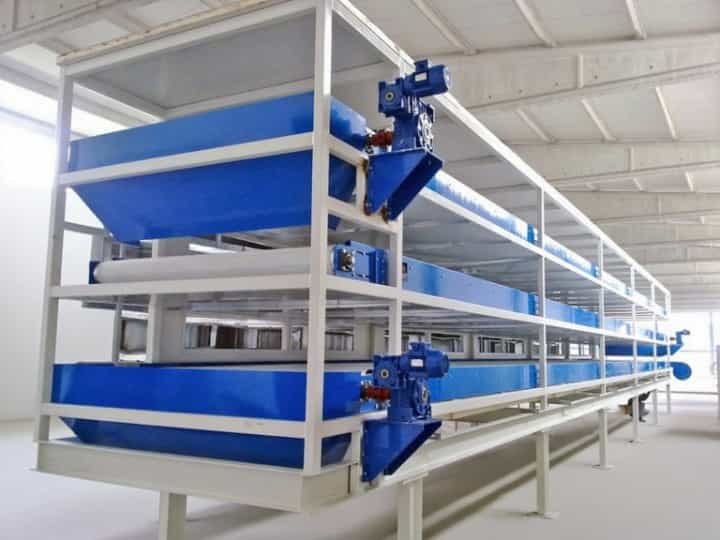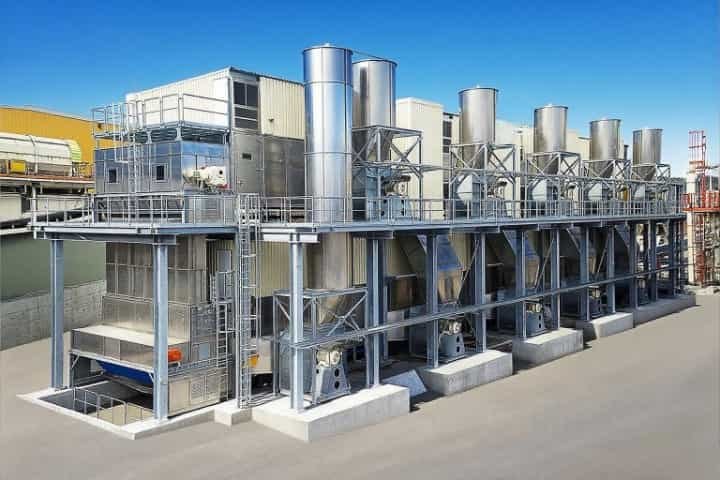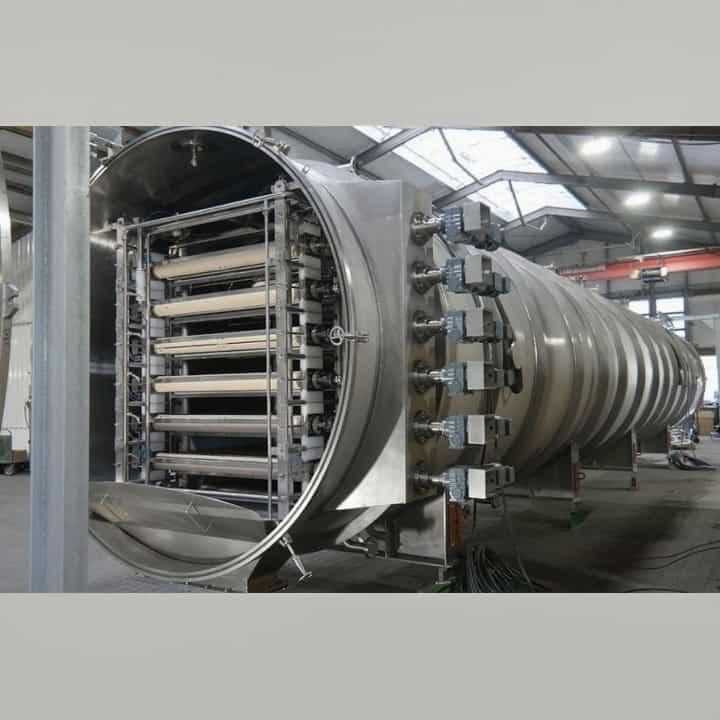A belt dryer is a machine that dries and cools things. It uses a moving belt to make sure materials dry evenly. Many businesses use belt dryers for food, chemicals, and medicines. This technology helps dry big amounts of products in a steady way. The belt dryer market was about USD 750 million in 2023. It keeps growing as more companies want to save energy.
Key Takeaways
A belt dryer dries things with a moving conveyor belt and hot air. It dries materials gently and evenly. This helps protect sensitive things like food and medicine.
Workers can change the heat, airflow, and belt speed. This helps keep the product good. It also saves energy and dries a lot at once.
There are different belt dryers. Some have one belt, some have many, and some use a vacuum. These fit small jobs, big factories, and items that need gentle heat.
Belt dryers save energy by using heat again. They also use automation to control drying better and lower costs.
Workers must check belts and clean dust often. This keeps the dryer working well and stops expensive repairs.
What Is a Belt Dryer?
A belt dryer is an industrial drying system designed to efficiently remove moisture from various products using a continuous conveyor belt. It is commonly utilized in food processing, chemical, and pharmaceutical industries for drying bulk materials.

Basic Principle
A belt dryer dries materials using a moving belt. Workers put wet products on a conveyor belt with holes. The belt carries the material through different drying sections. Hot air or drying gas blows over or through the product in each section. This air takes away the moisture from the material. Each section can have its own heat and airflow settings. The belt speed can be changed to control how long the material stays inside. This setup lets the dryer work gently and evenly. It helps keep sensitive products safe.
The belt dryer is different from other dryers. It works all the time and gives exact control. Workers can change the heat, airflow, and belt speed for each part. This makes the belt dryer machine good for many products. It is helpful for things that need gentle care. The machine’s design lets it dry a lot of material quickly.
When drying, materials change in both looks and chemistry. Water leaves the product, so it shrinks and feels different. Some things may lose color or nutrients if they get too hot. The belt dryer machine helps stop these problems. It lets workers control heat and airflow carefully. This protects things like vitamins and enzymes.
Tip: Workers should always check heat and airflow. This keeps products good and stops damage to sensitive materials.
Here is a table showing the main changes that happen to materials during belt drying:
Change Type | Description | Supporting Details and Effects |
|---|---|---|
Physical Changes | Water leaves, so things shrink, get smaller, and feel different | Shrinking changes quality and affects how water and heat move during drying |
How well things soak up water after drying changes | Soaking up water shows how drying changed the product | |
Chemical Changes | Heat can break down things like vitamins, enzymes, and active parts | Careful heat and airflow stop breakdown; too much heat means less nutrition |
Drying Mechanism | Infrared and moving air work together to dry things well | Infrared heats the inside; moving air takes away water and cools the outside |
Quality Impact | Drying can change nutrition, color, and taste | Good heat control keeps quality; bad drying loses nutrients and changes color or feel |
Key Components
A belt dryer machine has many important parts that work together. Each part has a special job in drying. The table below lists the main parts and what they do:
Component | Function |
|---|---|
Conveyor Belt System | Moves things through the dryer, making sure all parts get heat and air |
Heating System | Gives steady heat to dry things and keeps the right temperature |
Air Circulation System | Spreads hot air everywhere for even drying and steady heat and wetness |
Control Panel | Lets workers watch and change settings like heat, belt speed, and time |
Insulation | Keeps heat inside the dryer, saving energy and keeping heat steady |
The conveyor belt is a very important part of the belt dryer. It must be strong but also gentle so it does not hurt soft products. The heating system gives the right amount of heat for drying. The air system spreads hot air everywhere, so all parts dry the same. The control panel lets workers control the whole drying process. Insulation saves energy by keeping heat inside.
How well the belt dryer works depends on its design and parts. A belt dryer machine has many moving pieces, like bearings and motors. These parts can wear out and need to be checked often. The belt can break and is costly to fix if something sharp gets in. The in-feed system must spread material evenly on the belt for good drying. If dust or trash blocks the belt, air cannot move and drying slows down. Simple designs with fewer moving parts last longer and cost less to fix.
Note: Checking and fixing the belt dryer often keeps it working well and stops big repairs or long breaks.
How a Belt Dryer Machine Works
A belt dryer machine works by continuously feeding materials onto a moving conveyor belt, which passes through a series of drying chambers with controlled temperature and airflow. This process efficiently removes moisture from the materials.
Drying Process Steps
A belt dryer moves material on a flat conveyor belt. Workers put wet material, like a liquid or paste, into the machine. A special tool spreads the material out on the belt. This makes sure every part gets the same heat and air.
1. Put the raw material into the belt dryer machine. 2. Spread the material evenly on the conveyor belt system. 3. The belt moves through heated sections with plates underneath. 4. Hot air blows in the drying areas, sometimes under vacuum, to take out water. 5. Automation lets workers change temperature, pressure, and belt speed. 6. Cooling plates cool the dried product while it is still on the belt. 7. The finished product comes out of the machine. 8. Sometimes, the product is crushed or broken up to get the right size.
The way air moves inside the belt dryer is very important. Air can move up, down, or across the material. This helps dry everything the same way. Good air control stops some parts from drying too much or too little. Some belt dryers use special air tricks, like switching air direction or pulsing the air. These tricks help dry things evenly and stop problems. Workers can change how fast the air moves for different products. This keeps drying fast and protects the product.
Tip: Check the airflow and belt speed often. This helps the machine work well and gives good results.
Energy Sources
Belt dryers need energy to heat air and run the machine. Factories pick energy sources based on price and the environment. Many belt dryer machines use more than one energy source to work better.
Energy Source Type | Description |
|---|---|
Hot gases from burning natural gas mix with cooler dryer air to heat the system. | |
Waste Heat from Industrial Processes | Heat exchangers use leftover energy from cement kilns, waste-to-energy plants, or gas turbines. |
Hot Water from Gas Motors | Heat exchangers warm the dryer air using hot water from gas motors. |
Using waste heat from other factories saves energy and money. It also helps the environment. New technology lets belt dryers reuse more energy. This makes the system even better.
What Are the Key Features of Belt Dryers?
Belt dryers are continuous drying systems known for their efficiency and uniformity. Key features include a conveyor system, multi-stage drying zones, and precise temperature control.

Gentle Thermal Treatment
Belt dryers use gentle heat to keep materials safe. Workers set the temperature low or medium and slow down the belt. This stops things from getting too hot. Gentle air moves around to help keep food and other items healthy. The temperature is controlled carefully. Perforated belts let air move through everything. This helps all parts dry the same way. Drying chambers can be changed for each section. Workers can set different heat and air for each part. Some belt dryers use vacuum technology for extra care. These features help keep color, taste, and nutrients in the product.
Tip: The right belt and airflow settings protect delicate things from harm.
Automation and Control
Modern belt dryers use automation to control the process. Sensors check temperature, airflow, and belt speed all the time. This helps drying stay the same and stops mistakes. Automated systems help factories meet quality rules and work better. Multi-layer conveyor belts dry products the same way. This means less loss of nutrients and even drying. Automation also saves money on workers and helps make more products. New technology like IoT and AI controls use energy smarter and make changes faster.
Maintenance Needs
Belt dryers need regular care to work well. Belts can wear out and must be checked often. Workers adjust the belt and clean the system to stop buildup. Wet spots in the dryer can cause trouble, so cleaning and airflow checks matter. Factories that check drying zones every month work better and last longer. Belt dryers need more care than fluid bed dryers. Operators use special tools and change parts on a schedule to stop breakdowns and save energy. Safety steps, like wearing gear and following rules, help stop accidents and protect nature.
Dryer Type | Maintenance Needs |
|---|---|
Belt Dryers | Check belts often, clean, adjust tension, watch for dust, more work needed |
Fluid Bed Dryers | Easier to clean, less care needed, simple design |
Rotary Dryers | Focus on moving parts, need special service |
What Are the Different Types of Belt Dryer Machines
Belt dryer machines come in several types, primarily categorized by their design and application: single-stage, multi-stage, and vacuum belt dryers. Each type serves specific industrial needs.

Single-Belt vs. Multi-Belt
Belt dryer machines can have one belt or many belts. A single-belt dryer has just one conveyor belt. It moves products through the drying chamber. This design is simple and easy to use. It works best for things that only need basic drying. Single-belt dryers are good for small or medium jobs. They let workers control heat and air easily.
Multi-belt dryers have several belts stacked on top of each other. This saves space on the floor. It lets the machine dry more material at once. Multi-belt dryers are used in big factories. They can dry many things, like grains, herbs, snacks, and wood chips. Each belt can have its own settings for heat and speed. This helps dry everything evenly, even if the shape or size changes.
Multi-belt dryers need special airflow designs. Air can dry the edges faster than the middle. Engineers add flaps and guides to help all parts dry the same.
Here is a table that compares single-belt and multi-belt dryers:
Aspect | Single-Belt Dryer | Multi-Belt Dryer |
|---|---|---|
Design Complexity | Simple, one belt | Several belts stacked vertically |
Drying Capacity | Low to medium | High |
Drying Time | Shorter | Longer |
Space Use | Needs more floor space | Saves space with vertical design |
Heat Transfer | Basic | More efficient |
Energy Efficiency | Standard | Advanced, less heat loss |
Application Scope | Simple, uniform products | Many materials, complex needs |
Control Systems | Basic | Advanced, customizable |
Best Use | Small to medium jobs | Large-scale, flexible drying |
Multi-belt dryers use automation to help workers. This means less work and better control. They are great for drying lots of material in different ways.
Vacuum Belt Dryers
Vacuum belt dryers use a vacuum to dry things at low heat. The temperature is often below 80°C. This gentle way keeps heat-sensitive things safe, like medicines and food nutrients. The vacuum makes water boil at a lower temperature. This means drying is faster and cooler.
These machines work all the time without stopping. The belt moves things gently, so they do not break. Vacuum belt dryers also reuse heat. This saves energy and lowers costs.
Some vacuum belt dryers have extra tools. They can grind, recover solvents, and follow strict safety rules. They are good for sticky or thick things that are hard to dry. Drying is much faster than freeze dryers or vacuum ovens. The final product keeps its color, taste, and nutrients.
Factories use vacuum belt dryers for many things:
Industry | Product Types |
|---|---|
Food Industry | Vegetables, fruits, coffee, dairy, dough, malt mixes, meat extracts, herbal extracts |
Pharmaceutical Industry | Sensitive medicines, herbal extracts |
Chemical Industry | Paint, plastic pellets, other chemicals |
Vacuum belt dryers help factories make good products fast and safe. They save energy and protect sensitive ingredients.
What Are the Applications of Drying Materials?
Drying materials are used in various industries to remove moisture from products, ensuring stability, longevity, and quality. They are vital in pharmaceuticals, food preservation, electronics, and packaging.

Drying Materials in Food Industry
Belt dryers are important in food factories. They dry cut fruits and vegetables. These machines also dry pet food, granola, and baked goods. The belt dryer uses a conveyor with holes and hot air. This dries food fast and evenly. Multi-stage and multi-layer belt dryers help control heat and belt speed. This helps keep the food’s color, taste, and nutrients. Even drying stops food from spoiling and makes it last longer. Factories use belt dryers for nonstop, automatic work. They are gentle with soft foods and keep them good.
Tip: Steps like cutting, crushing, or mixing help get food ready for drying. These steps make sure food dries the same and does not stick together.
Biomass and Environmental Uses
Belt dryers help with biomass and the environment. They dry woodchips, pellets, and other biomass. Drying is needed so these things burn well and make less smoke. When biomass is dry, it burns better and cleaner. Some belt dryers use leftover heat from other machines. This saves energy and money. These dryers can be used in many places because of their design. Drying things like sludge or wood waste turns trash into fuel. This helps make cleaner energy.
Chemical and Pharmaceutical Applications
Chemical and drug companies use belt dryers for special jobs. These dryers let workers control heat, air, and drying time. This keeps important parts safe and protects the product. Belt dryers often work in closed systems. This stops dust from getting out and keeps workers safe. In drug factories, belt dryers help meet strict rules. They dry active ingredients and other parts without hurting them. Steps like grinding or mixing help get powders and pastes ready to dry. Careful drying makes sure products are safe and high quality.
Industry | Typical Products | Pre-Treatment Needed |
|---|---|---|
Food | Fruits, vegetables, snacks | |
Biomass | Woodchips, pellets, sludge | |
Chemical/Pharma | Powders, extracts, APIs | Grinding, mixing |
A belt dryer has many good points for drying things. Some main benefits are:
It works for many kinds of things and job sizes.
It does not need much space and is simple to set up.
Picking the best belt dryer depends on what you need to dry, how you want to dry it, and how much room you have. The table below lists what you should think about:
Factor Category | Key Considerations |
|---|---|
Material Properties | How wet it is, if it is heat sensitive |
Output & Planning | How much you want to make, your future plans |
Installation | How much space you have, what energy you use, and rules |
People new to this can look at more choices to find what works best for their work.
FAQ
What materials can a belt dryer handle?
A belt dryer can dry many things. Factories use it for food, chemicals, medicines, woodchips, and pellets. It works well with powders, pastes, and small pieces.
How does a belt dryer save energy?
A belt dryer saves energy by reusing heat from other machines. Some models use waste heat or hot water. This lowers energy costs and helps the environment.
Is a belt dryer easy to clean and maintain?
Regular cleaning keeps a belt dryer working well. Workers check belts, clean dust, and adjust parts. Some designs make cleaning easier with simple access panels.
Can a belt dryer damage sensitive products?
A belt dryer uses gentle heat and slow airflow. This protects vitamins, color, and taste. Workers can set the right temperature and speed for each product.

